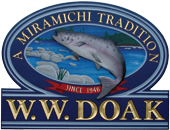Farley Mowatt in his book "Sea of Slaughter" states:
During the late 1950's the United States Navy began sending submarines north under the Arctic ice, and one of them made a surprising discovery. Beneath the verges of the Baffin Bay pack it encountered gleaming hordes of large fishes that, after some confusion, were identified as Atlantic salmon. The discovery was particularly important because, until then, no one had known where Atlantic salmon spent their time once they departed from the continental coasts for their long sojourn at sea. First to make capital of the discovery were the Danes, closely followed by the Norwegians.
(Read Text)
In the British house of Lords, Lord Balfour spoke on July 5, 1965
.........Atlantic Salmon from Greenland have risen from 2 metric tons in 1957 to 1,400 metric tons in 1964 due to growth of intense netting using improved methods
.......Your Lordships may have heard, as I have, from two sources, the story of one of the American Atlantic submarines taking the Northern Passage. Through the periscope they saw on an iceberg—and your Lordships know that about one-third of an iceberg shows and two-thirds are below—what they thought were tens of thousands of nodules. Going close they found, through the periscope, that in fact these were salmon vertical, tail down, nose up, sucking plankton from the bottom of icebergs; and those salmon had passed round the Greenland coast.
With this new knowledge and with its exploitation by modern equipment and ever improving methods, the raids on salmon stocks are increasing, in terms, I regret to say, of largely immature fish. (full text)
The New York Times writes:
In the 1960's, a net fishery for salmon began in the Davis Strait off Greenland, a self-governing overseas state of Denmark. Participants included Greenlanders and others. Salmon from Canada, the United States, the United Kingdom and Europe journey there to feed and grow before returning to home rivers.
From the mid-1960's on, it was clear that the salmon could only be saved by an international effort. This resulted in the multination North Atlantic Salmon Conservation Organization, which each year uses data provided by the International Commission for Exploration of the Sea to establish a quota for the Greenland fishery. (Full Text) |

